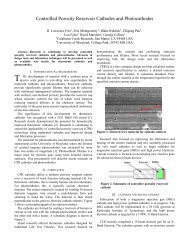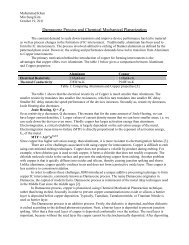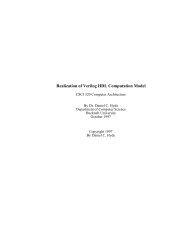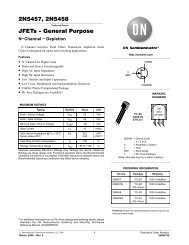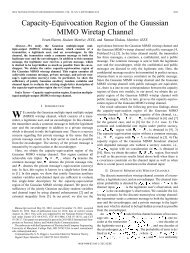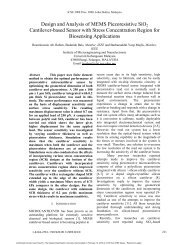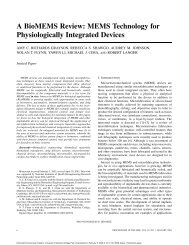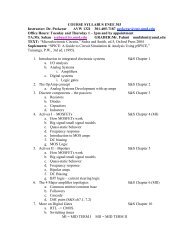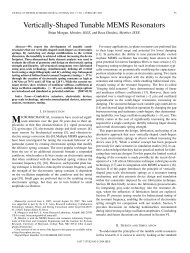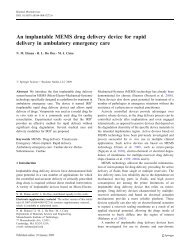Purpose RiSC-16 Instruction Set Project 1: Assembler ... - ECE
Purpose RiSC-16 Instruction Set Project 1: Assembler ... - ECE
Purpose RiSC-16 Instruction Set Project 1: Assembler ... - ECE
You also want an ePaper? Increase the reach of your titles
YUMPU automatically turns print PDFs into web optimized ePapers that Google loves.
There are 3 machine-code instruction formats: RRR-type, RRI-type, and RI-type.<br />
All addresses <br />
are shortword-addresses (i.e. address 0 corresponds to the first two bytes of main memory,<br />
address 1 corresponds to the second two bytes of main memory, etc.). Like the MIPS instruction-set<br />
architecture, <br />
by hardware convention, register 0 will always contain the value 0. The machine enforces<br />
this: reads <br />
to register 0 always return 0, irrespective of what has been written there. The <strong>RiSC</strong>-<strong>16</strong> is very<br />
simple, but <br />
it is general enough to solve complex problems. The following table describes the different<br />
<br />
instruction operations.<br />
Mnemonic<br />
<br />
<br />
<br />
Opcode Assembly<br />
Name and Format<br />
(binary) Format<br />
<br />
<br />
<br />
<br />
<br />
Action<br />
<br />
<br />
add<br />
Add<br />
RRR-type 000<br />
<br />
<br />
add rA, rB, rC<br />
<br />
Add contents of regB with regC,<br />
store result <br />
in regA.<br />
<br />
addi<br />
nand<br />
lui<br />
sw<br />
lw<br />
bne<br />
jalr<br />
001 addi rA, rB, imm<br />
<br />
Nand<br />
RRR-type<br />
<br />
<br />
<br />
010<br />
<br />
<br />
<br />
<br />
<br />
nand rA, rB, rC<br />
<br />
Load Upper Immediate<br />
<br />
RI-type<br />
<br />
011<br />
<br />
lui rA, imm<br />
<br />
Store Word<br />
<br />
RRI-type<br />
Load Word<br />
<br />
RRI-type<br />
Add contents <br />
of regB with imm,<br />
<br />
store result in regA.<br />
<br />
Nand <br />
contents of regB with regC,<br />
store results in regA.<br />
<br />
<br />
Place the top 10 bits of the <strong>16</strong>-bit imm into the top 10 bits of regA,<br />
<br />
setting the bottom 6 bits of regA to zero.<br />
<br />
Store value <br />
<br />
from regA into memory. Memory address is formed by adding<br />
100 sw rA, rB, imm<br />
<br />
<br />
imm with contents of regB.<br />
101 lw rA, rB, imm<br />
<br />
Load value <br />
from memory into regA. Memory address is formed by adding<br />
<br />
imm with contents of regB.<br />
<br />
Branch if Not Equal<br />
If the contents of regA and regB are not the same, branch to the address<br />
<br />
110 bne rA, rB, imm<br />
RRI-type<br />
PC+1+imm, where PC is the address of the bne instruction.<br />
Jump And Link Register<br />
RRI-type<br />
ENEE 646: Digital Computer Design — <strong>Project</strong> 1 (10%)<br />
<br />
<br />
<br />
<br />
Add Immediate <br />
<br />
<br />
RRI-type<br />
<br />
<br />
<br />
<br />
<br />
<br />
<br />
<br />
<br />
<br />
<br />
<br />
<br />
Branch to the address in regB.<br />
111 jalr rA, rB<br />
<br />
<br />
<br />
Store PC+1 into regA, where PC is the address of the jalr instruction.<br />
Note that the 8 <br />
basic instructions of the <strong>RiSC</strong>-<strong>16</strong> architecture form a complete ISA that can perform<br />
arbitrary computation. For example:<br />
<br />
<br />
<br />
<br />
<br />
<br />
<br />
• Moving <br />
constant values into registers. The number 0 can be moved into any register in one<br />
cycle (add <br />
rX r0 r0). Any number between -64 and 63 can be placed into a register in one<br />
operation using the ADDI instruction (addi rX r0 number). Moreover, any <strong>16</strong>-bit number<br />
<br />
can be moved into a register in two operations (lui+addi).<br />
• Subtracting numbers. Subtracting is simply adding the negative value. Any number can be<br />
made negative in two instructions by flipping its bits and adding 1. Bit-flipping can be done by<br />
NANDing the value with itself; adding 1 is done with the ADDI instruction. Therefore,<br />
subtraction is a three-instruction process. Note that without an extra register, it is a destructive<br />
process.<br />
• Multiplying numbers. Multiplication is easily done by repeated addition, bit-testing, and leftshifting<br />
a bitmask by one bit (which is the same as an addition with itself).<br />
<br />
<br />
<br />
2



